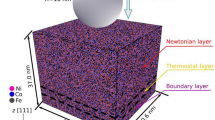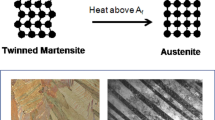Abstract
The majority of data generated today is stored in magnetic storage hard disk drives (HDD) of enterprise-level data centers. The HDD industry is striving for higher areal density capacity to meet increasing demand for data storage. Heat-assisted magnetic recording (HAMR) has been proposed as the next-generation technology that will bring revolutionary areal density gains. However, the technology comes with elevated temperature conditions and inevitably brings corresponding challenges to the head–disk interface (HDI). HDI high temperature tribology is the primary failure mode of HDDs and is discussed in the present work. Temperature dependence of mechanical properties, friction, wear and adhesion are reported based on experimental results from nanoindentation, nanoscratch, nanowear and adhesion experiments. The data reveals quantitative variations of Young’s modulus, hardness, coefficient of friction, and surface energy with temperature. In addition, XPS analysis is performed to measure chemical surface changes, and correlated with the nanomechanical findings.
Graphical Abstract











Similar content being viewed by others
References
Reinsel, D., Gantz, J., Rydning, J.: Data age 2025: the digitization of the world from edge to core (2018). https://www.seagate.com/files/www-content/our-story/trends/files/idc-seagate-dataage-whitepaper.pdf. Accessed 11 Oct 2020
ASTC Technology Roadmap. https://idema.org/?page_id=5868
Rai, R., Bhargava, P., Knigge, B., Murthy, A.N.: A method for monitoring head media spacing change in a hard disk drive using an embedded contact sensor. Microsyst. Technol. (2020). https://doi.org/10.1007/s00542-020-04911-9
Trinh, T.D., Sullivan, M., Kirpekar, S., Talke, F.E.: Effect of air and helium on the head–disk interface during load–unload. Tribol. Lett. 66(1), 39 (2018)
Kryder, M.H., Gage, E.C., McDaniel, T.W., Challener, W.A., Rottmayer, R.E., Ju, G., Hsia, Y.T., Erden, M.F.: Heat assisted magnetic recording. Proc. IEEE 96(11), 1810–1835 (2008)
Weller, D., Parker, G., Mosendz, O., Champion, E., Stipe, B., Wang, X., Klemmer, T., Ju, G., Ajan, A.: A HAMR media technology roadmap to an areal density of 4 Tb/in2. IEEE Trans. Magn. 50(1), 1–8 (2013)
Marchon, B., Pitchford, T., Hsia, Y.T., Gangopadhyay, S.: The head–disk interface roadmap to an areal density of 4 Tbit/in2. Adv. Tribol. (2013). https://doi.org/10.1155/2013/521086
Strom, B.D., Lee, S., Tyndall, G.W., Khurshudov, A.: Hard disk drive reliability modeling and failure prediction. IEEE Trans. Magn. 43(9), 3676–3684 (2007)
Dahl, J.B., Bogy, D.B.: Lubricant flow and evaporation model for heat-assisted magnetic recording including functional end-group effects and thin film viscosity. Tribol. Lett. 52(1), 27–45 (2013)
Tagawa, N., Andoh, H., Tani, H.: Study on lubricant depletion induced by laser heating in thermally assisted magnetic recording systems: effect of lubricant thickness and bonding ratio. Tribol. Lett. 37(2), 411–418 (2010)
Jones, P.M., Ahner, J., Platt, C.L., Tang, H., Hohlfeld, J.: Understanding disk carbon loss kinetics for heat assisted magnetic recording. IEEE Trans. Magn. 50(3), 144–147 (2014)
Mangolini, F., Rose, F., Hilbert, J., Carpick, R.W.: Thermally induced evolution of hydrogenated amorphous carbon. Appl. Phys. Lett. 103(16), 161605 (2013)
Zhang, Y., Polychronopoulou, K., Humood, M., Polycarpou, A.A.: High temperature nanotribology of ultra-thin hydrogenated amorphous carbon coatings. Carbon 123, 112–121 (2017)
Marchon, B., Guo, X.C., Pathem, B.K., Rose, F., Dai, Q., Feliss, N., Schreck, E., Reiner, J., Mosendz, O., Takano, K., Do, H.: Head–disk interface materials issues in heat-assisted magnetic recording. IEEE Trans. Magn. 50(3), 137–143 (2014)
Kiely, J.D., Jones, P.M., Yang, Y., Brand, J.L., Anaya-Dufresne, M., Fletcher, P.C., Zavaliche, F., Toivola, Y., Duda, J.C., Johnson, M.T.: Write-induced head contamination in heat-assisted magnetic recording. IEEE Trans. Magn. 53(2), 1–7 (2016)
Xiong, S., Wang, N., Smith, R., Li, D., Schreck, E., Dai, Q.: Material transfer inside head disk interface for heat assisted magnetic recording. Tribol. Lett. 65(2), 74 (2017)
Kiely, J.D., Jones, P.M., Hoehn, J.: Materials challenges for the heat-assisted magnetic recording head–disk interface. MRS Bull. 43(2), 119–124 (2018)
Zhang, Y., Oh, Y., Stauffer, D., Polycarpou, A.A.: A microelectromechanical systems (MEMS) force–displacement transducer for sub-5 nm nanoindentation and adhesion measurements. Rev. Sci. Instrum. 89(4), 045109 (2018)
Kobayashi, T., Nakatani, Y., Fujiwara, Y.: Media design for three-dimensional heat-assisted magnetic recording. J. Magn. Soc. Jpn (2020). https://doi.org/10.3379/msjmag.2009R004
Johnson, K.L.: The correlation of indentation experiments. J. Mech. Phys. Solids 18(2), 115–126 (1970)
Zhang, Y., Wang, H., Li, X., Tang, H., Polycarpou, A.A.: A finite element correction method for sub-20 nm nanoindentation considering tip bluntness. Int. J. Solids Struct 129, 49–60 (2017)
Zhang, Y., Shakil, A., Wang, H., Li, X., Tang, H., Polycarpou, A.A.: Effects of SiO2 content on the nanomechanical properties of CoCrPt–SiO2 granular films. Sci. Rep. 9(1), 1–8 (2019)
Bhushan, B., Koinkar, V.N., Ruan, J.A.: Microtribology of magnetic media. Proc. Inst. Mech. Eng. J 208(1), 17–29 (1994)
Prabhakaran, V., Talke, F.E.: Wear and hardness of carbon overcoats on magnetic recording sliders. Wear 243(1–2), 18–24 (2000)
Lee, K.M., Yeo, C.D., Polycarpou, A.A.: Nanomechanical property and nanowear measurements for sub-10-nm thick films in magnetic storage. Exp. Mech. 47(1), 107 (2007)
Bhushan, B.: Nano- to microscale wear and mechanical characterization using scanning probe microscopy. Wear 251(1–12), 1105–1123 (2001)
Erdemir, A.: The role of hydrogen in tribological properties of diamond-like carbon films. Surf. Coat. Technol. 146, 292–297 (2001)
Wang, N., Komvopoulos, K.: Thermal stability of ultrathin amorphous carbon films for energy-assisted magnetic recording. IEEE Trans. Magn. 47(9), 2277–2282 (2011)
Miyake, S., Yamazaki, S.: Nanoscratch properties of extremely thin diamond-like carbon films. Wear 305(1–2), 69–77 (2013)
Ma, X.G., Komvopoulos, K., Wan, D., Bogy, D.B., Kim, Y.S.: Effects of film thickness and contact load on nanotribological properties of sputtered amorphous carbon thin films. Wear 254(10), 1010–1018 (2003)
Mate, C.M., Deng, H., Lo, G.J., Boszormenyi, I., Schreck, E., Marchon, B.: Measuring and modeling flash temperatures at magnetic recording head–disk interfaces for well-defined asperity contacts. Tribol. Lett. 58(2), 27 (2015)
Ovcharenko, A., Yang, M., Chun, K., Talke, F.E.: Simulation of magnetic erasure due to transient slider-disk contacts. IEEE Trans. Magn. 46(3), 770–777 (2010)
Sakhalkar, S.V., Bogy, D.B.: A model for lubricant transfer from media to head during heat-assisted magnetic recording (HAMR) writing. Tribol. Lett. 65(4), 166 (2017)
Seo, Y.W., Rosenkranz, A., Talke, F.E.: Molecular dynamics study of lubricant depletion by pulsed laser heating. Appl. Surf. Sci. 440, 73–83 (2018)
Acknowledgements
The motivation of this work was through a Sponsored Research Program from Seagate Technology LLC, through Grant No. SRA-32724. The TEM image was measured by Dr. X. Zhang, Texas A&M University (now at Purdue University). The XPS analysis was contributed by Dr. K. Polychronopoulou, Khalifa University, while on visit at Texas A&M.
Author information
Authors and Affiliations
Corresponding author
Additional information
Publisher's Note
Springer Nature remains neutral with regard to jurisdictional claims in published maps and institutional affiliations.
Rights and permissions
About this article
Cite this article
Zhang, Y., Tang, H. & Polycarpou, A.A. High Temperature Mechanics, Friction, Wear and Adhesion of Heat-Assisted Magnetic Recording. Tribol Lett 68, 109 (2020). https://doi.org/10.1007/s11249-020-01348-z
Received:
Accepted:
Published:
DOI: https://doi.org/10.1007/s11249-020-01348-z




